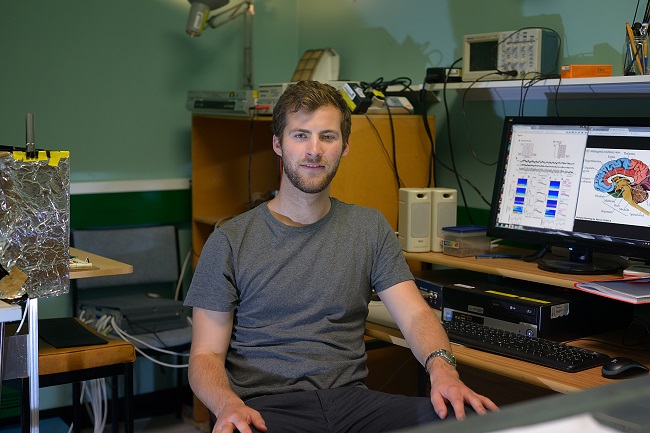 Thoma Elston, PhD candidate
Thoma Elston, PhD candidate
University of Otago neuroscience PhD candidate Thomas Elston hopes his research will lead to a more robust way to diagnose psychiatric conditions.
Thomas has been studying how effort is anticipated in the brain at the Brain Health Research Centre. He analyses what happens in the brains of rats trained to complete either an easy or hard route in a maze. The rats can anticipate beforehand (based on the image on a touchscreen) which route is coming up - the image cues a memory of past experience, giving the rat meaningful expectation.
In people with conditions like schizophrenia, addiction and impulsive disorders, this circuitry is dysfunctional.
Neural synchrony the key
“Your ability to think about one thing as opposed to another thing is self-control ... So the breakdown of these systems, especially in the cases of schizophrenia and addiction, is ultimately a breakdown in the circuitry allowing you to have self-control. You can't control your own thoughts and behaviour.”
There are several levels of application for his research, but his personal favourite is neural synchrony – when two brains cells are synchronised in their firing, they form a connection which translates to memories and association; cells that fire together, wire together.
Thomas also says that brain regions that fire together, function together. The hippocampus makes memories and the anterior cingulate region helps us make choices.
“So if you see these two areas synchronised, that tells you that you are using a memory to help you make a choice. The ultimate application, my vision for this kind of research, is to use this neural synchrony idea as a way to diagnose psychiatric diseases.”
Using an EEG, it is possible to point to physical phenomena in the brain characteristic of virtually every major psychiatric condition. These synchrony profiles show when multiple parts of the brain are not working together as they should to produce normal consciousness.
Using this synchronisation as a bio-marker for different diseases is an objective way to diagnose, as opposed to subjective evaluation. Thomas is unsure why this approach is not currently clinical practice.
“Maybe because it's so specific it hasn't been useful until now.”
Plan for a biotech company
Thomas says the solution is inexpensive ($5000 for an EEG machine) and resulting data easy to analyse and his long-term goal is to start a biotechnology company providing a diagnostic service using synchrony profiles.
Thomas loves the freedom he has at Otago to explore different types of experiments and methods and he also enjoys the work-life balance in the PhD process here.
“No matter where you are there is a certain amount of stuff you just have to do; but you don't have to be stressed out about it. On a personal level that's my favourite aspect of being here.”
Thomas' supervisor, Professor David Bilkey, of the Department of Psychology, is the reason Thomas was attracted to Otago. While doing an undergraduate degree research project at Baylor University (Texas), he was impressed by David's work. The pair communicated online before meeting at a neuroscience convention. “Everything just sort of fell into place.”
